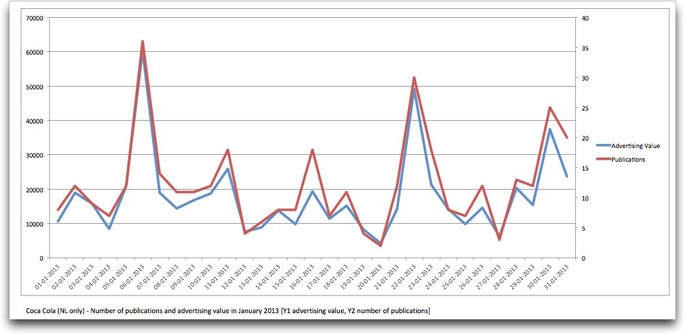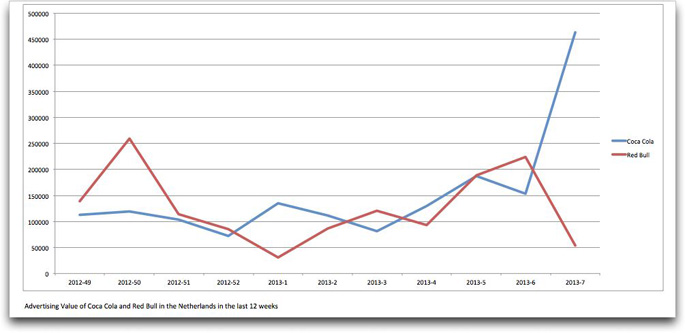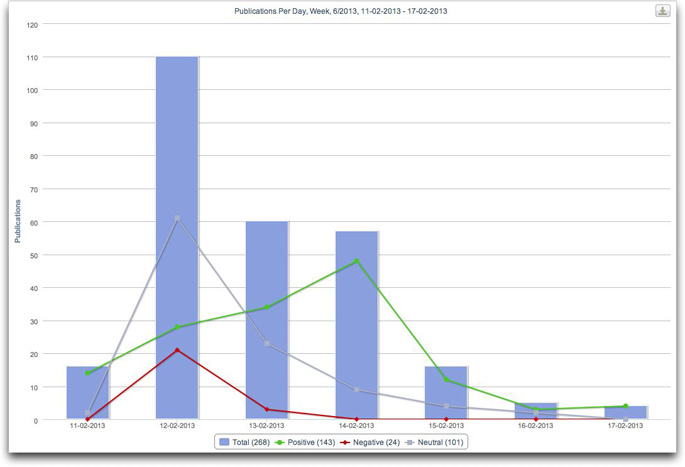In our last blogpost we witnessed the excitement before the release of the new Coca Cola commercial marking the countdown to the holidays. This time we’re going to zoom in on Coca Cola’s advertising value and we’re going to focus on one country only in this example. We’ll demonstrate that the Advertising Value Equivalency can be used to measure the efficacy of PR efforts though this number should be enhanced with other measures and qualitative analysis to tell the actual story behind the number.
What is Advertising Value Equivalency?
The Advertising Value Equivalency (AVE) is actually not about value but about cost. It refers to what your editorial coverage would cost if it were advertising space (editorial quantity (time, surface) * unit cost). For the offline publications in BuzzTalk this is determined by the size of the publication. For the online publications (as shown in this example) this is determined via an algorithm that takes into account the amount of monthly visitors as well as the expected timeframe during which the article is prominently featured to website visitors.
The graph below shows the number of online publications and the daily total for the Advertising Value Equivalency for Coca Cola in the Netherlands in the month January 2013. If you would zoom in on a daily level to discover the individual publications you would see that the national newspapers generate a higher advertising value per publication as compared to local news sites or niche sites.

Benchmark and monitor Advertising Value Equivalency in time
Every publication, in every language across the world, is assessed in the same way. This makes it possible to benchmark brands and to monitor brands in time. For benchmarking and trend watching you don’t need the absolute number to be correct, you just need to have a standardized way of measuring things. Let me clarify this further using a metaphor. Suppose you start a diet in order to loose weight. Your scales may not be calibrated but still you can weigh yourself every week and monitor your weight loss in time. Likewise if your scales is not calibrated you can compare your weight against that of your weight loss buddy and see who’s the heaviest. This can only go wrong when you weigh yourself at home on week 1 at the gym on week 2 and at your buddy’s home on week 3. When switching measuring methods you cannot effectively monitor trends or compare against each other. So it’s crucial to stick to one method.
We evaluated the last 11 complete weeks in which Coca Cola was mentioned in 1070 online publications in the Netherlands. This generated an advertising value of 1,668 K euro’s. Is this a lot? Let’s compare it to Red Bull, the other well-known carbonated caffeinated high-sugar drink but with a much smaller marketing budget. In the same time period and region they generated an Advertising Value of 1,395 K euro’s (84% of that of Coca Cola). Red Bull was mentioned in 857 online publications making an average publication worth 1576 euro’s which is slightly higher than the average publication mentioning Coca Cola.

Drawbacks of Advertising Value Equivalency
Advertising Value measurements enable you to determine the value of publicity as if these were euro’s spend. It does however have a few weaknesses that you should take into account. Suppose you are a PR firm trying to keep a story out of the news for your client. In that case a lower advertising value would actually be beneficial. Likewise, a higher Advertising Value doesn’t necessarily help your client increase their profits. Surely you can find examples where bad publicity turned out to be good, but to assume that “there is no such thing as bad publicity” would be foolish. Just think about BP and the oil spill, the recurrent recalls that Toyota has to deal with or personal drama’s like Tiger Woods and Lance Armstrong. Their Advertising Value went through the roof, but didn’t bring them more money.
In addition Advertising Value Equivalency only reflects inches (or centimeters as we do here in the Netherlands) for offline media or eyeballs for online media. It does not take into account the true value and consequences of the publication for the company involved. Let’s illustrate this further by going back to our example.
The previous graph showed that Coca Cola seemed to be doing a whole lot better as compared to Red Bull in the last week. Let’s go and find out what the numbers are trying to tell us. In our online BuzzReport we can simply drill down in time to discover the most publications are on February 12th 2013 (see graph below). In particular we see a lift in publications labeled with a negative sentiment.

It appears a woman from New Zealand died because of drinking too much Coca Cola according to the pathologist. So while these publications do generate an increase in advertising value, this may not be the kind of publicity you would pursue as a company. Coca Cola now has to defend their soft drink by emphasizing that any grossly excessive ingestion of any food product, including water, can be harmful.
This example shows you that while numbers are highly valuable indicators pointing you in the right direction for further research, you cannot simply rely on numbers alone. There is a story behind them.
Uncover the story and enhance the Advertising Value Equivalency with a qualitative analysis using BuzzTalk
To find the ROI of Public Relations the Advertising Value Equivalency alone is not enough. No single measure will be as there is not a number that can reliably sum up engagement. It’s best to use AVE as part of a wider series of measurements. In addition, you can enhance the value of the Advertising Value Equivalency report by providing an in depth analysis to your management or client. Using BuzzTalk you can zoom in on the publications, use events, sentiment and mood states as navigational measures, and find out what the exposure is actually about, what it means for your client and how they can use it to their advantage (or take measures to steer away from it). Using a BuzzReport you can monitor various measures in time to see whether a particular intervention or campaign has an effect on both Advertising Value Equivalency, tone though sentiment and mood states, and the type and reach of influencers writing about you.
How do you define and measure PR success? Let us know via the comments.

Recent Comments